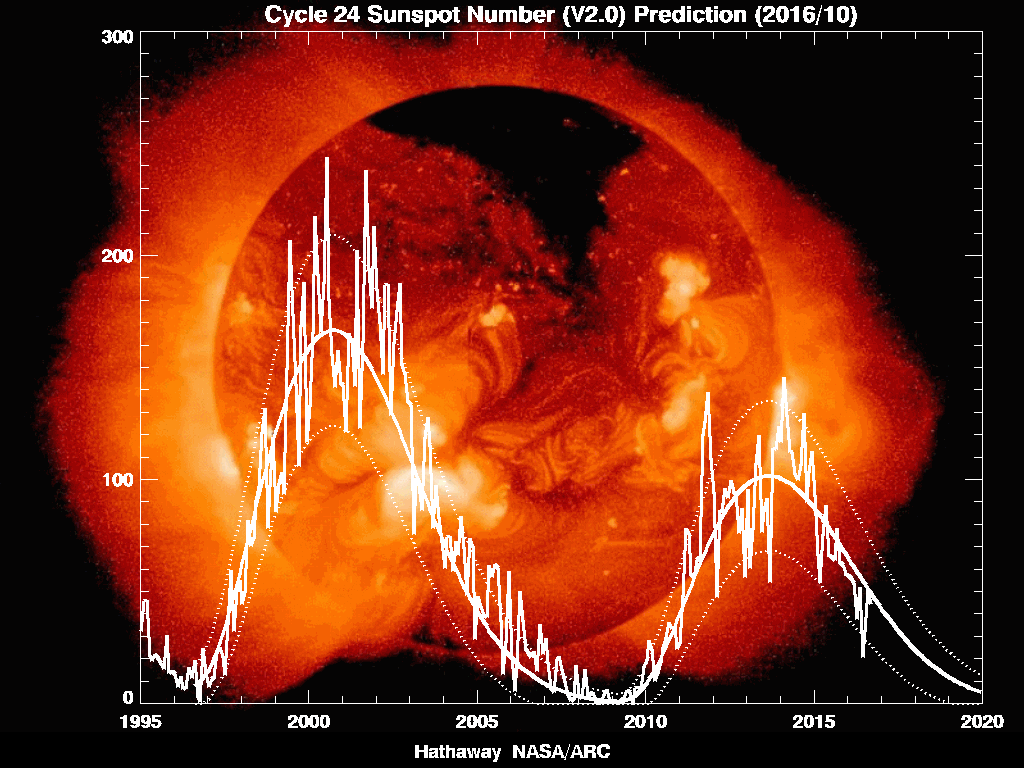Information on the behaviour of the sun is always of great
interest to radio amateurs. Here we provide some useful information regarding the
sun, and some links to useful pages on the web.
Solar Cycle 24
The graph below illustrates the performance
of Solar Cycle 24. For more information visit the Solar Physics page at
NASA. http://solarscience.msfc.nasa.gov/predict.shtml

Record of Solar Activity over time.
Click
here for sunspot number graphs since 1750!
Solar picture on the Home Page
The small picture on the Home Page is taken live from the Current Solar Images page on
the NASA website. (http://umbra.nascom.nasa.gov/images/latest.html
). This page is updated automatically every few hours, and shows mini-views of the sun
obtained from various different sources. The first few pictures on this page are
obtained from the SOHO satellite, the SOlar and Heliospheric Observatory. Refer to
page http://sohowww.nascom.nasa.gov/ for
more information on this fascinating resource. Clicking on any of the small images on this
page will download a larger version of the picture.
These images are provided by courtesy of The SOHO EIT Consortium; SOHO is a joint
ESA-NASA program.
Occasionally there will be no image, but the word "Bakeout" will appear in
its place. The following explanation is from Joe Gurman, Facility Scientist at
SDAC, the
Solar Data Analysis Center, who maintains the web site:
The CCD (backside-thinned, EUV-sensitive) detector on EIT requires baking out
(raising operating temperature from its normal, ~ -67 C, to ~ +16 C) in order to
"cure" throughput losses in the detector caused by the very EUV photons we want
to image. Normally, we perform bakeouts ~ every 4 months. We perform an exhaustive series
of tests and calibrations before and after each bakeout.
Interestingly, the environment at L1 is much more benign than low earth
orbit (LEO) or geosynchronous orbit (GO). In LEO, spacecraft pass in and out of the lowest
parts of the Van Allen belts (the "South Atlantic Anomaly" is the largest)
nearly every orbit, and if in polar or near-polar orbit, can get a concentrated dose of
SEP's if a proton event occurs --- such events last at least as long in the earth's
magnetosphere as they do at L1, and often longer, as the magnetosphere relaxes. GO's get
two different whammies: the geotail when on the nightside, and, during major solar storms,
the compression of the magnetosphere leaves the GO satellites open to the full proton
fluence. GO satellites in particular run the risk of passing through magnetosheath current
surfaces and can be seriously damaged by "charging up." Cf. the Telstar 401
satellite lost in 1997 January.
SEP's are also a danger for SOHO, both in single-event upsets to the electronics
(most of which can be dealt with in software or hardware), as are micrometeorites, but
both are relatively low probability events (though we've had both already). In general,
the lack of day-night thermal cycling is much more important for the survivability of the
spacecraft than any of the above.
Solar Terrestrial Activity Report
This extremely useful page ( http://dxlc.com/solar/
) is maintained by Jan Alvestad, webmaster of the Norway DX-Listeners' Club. It
contains a graph which is updated daily, showing the Sunspot Number, the Solar Flux, and
the Planetary A-Index for the last two months.
Notes are also provided on Solar activity which may give rise to geo-effective
conditions, and predictions of expected solar activity.
Live Solar report
Updated every 10 min
Solar X-rays:
Geomagnetic Field: |
| |
From n3kl.org
